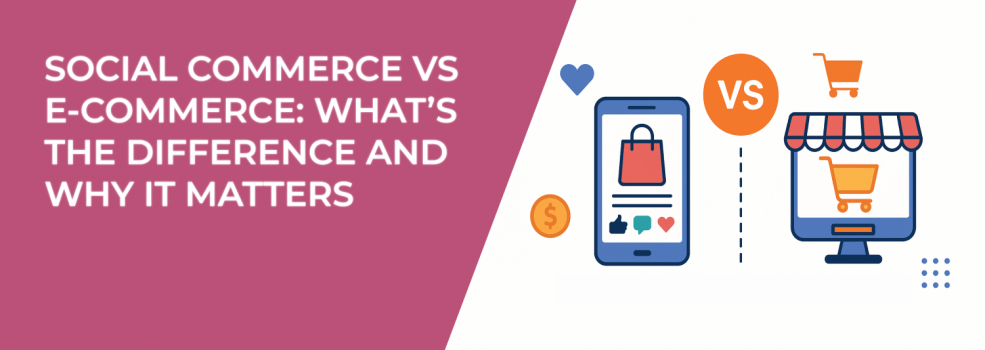If your team is still treating social commerce and e-commerce as the same thing, it’s time to take a closer look. They don’t just sound different — they work differently, and they serve different behaviors. This guide breaks down both models so you can align your ads, offers, and expectations.
What Is E-Commerce?
E-commerce is what most people think of when they hear "online shopping." It's the digital version of a store. Someone browses, clicks, and buys — usually through a website, online marketplace, or app.
From Amazon to Shopify, e-commerce is about building your storefront and bringing customers there. The transaction happens away from the ad platform — often through email, search engines, or paid ads that drive to product pages.
Think of it as:
- Product → Website → Checkout
But here’s the catch: people don’t always shop when they’re shopping. Sounds confusing? It is. And that’s where social commerce shifts the pattern.
What Is Social Commerce?
Social commerce is commerce inside the social platform.
The entire shopping journey — discovery, interaction, purchase — happens within apps like Instagram, Facebook, Pinterest, or TikTok. No redirection. No separate storefront. Users go from ad to checkout without ever leaving the feed.
It works best where engagement is native and trust is high.
A typical flow might look like:
- See an Instagram Reel → Click “Shop Now” → Purchase via Instagram Checkout
No tabs open. No cart abandonment from switching apps. Just fast, frictionless conversions.
And that subtle difference matters a lot when you're building your ad strategy.
Social Commerce vs E-Commerce: Key Differences
Let’s break down what really separates the two. Same goal (sales), very different routes.
-
Platform location: E-commerce happens off-platform — usually on a website or third-party marketplace. Social commerce keeps everything within Facebook, Instagram, or TikTok.
-
User mindset: E-commerce users often have clear buying intent. They searched for something, clicked on a product, and expect a full storefront. Social commerce users are browsing. They're in “discovery mode,” not necessarily ready to buy — until the right post stops their scroll.
-
Checkout experience: In e-commerce, the shopper leaves the platform to complete the purchase. Social commerce allows checkout directly within the app, which lowers friction and increases conversion rates.
-
Content strategy: E-commerce relies on detailed product pages, professional visuals, and structured funnels. Social commerce demands native-style content — Reels, Stories, carousels, and video-first creatives.
-
Ad goals and structure: E-commerce campaigns typically drive traffic to a site or landing page. Social commerce is optimized for in-platform conversion and engagement. The product is the ad, and the ad is the store.
If you’re unsure how to structure your campaign around these differences, check out Meta Ad Campaign Objectives Explained — it’s a useful guide to aligning your strategy with the right goal.
Why the Difference Matters for Marketers
1. Ad Creative Needs to Match Intent
With e-commerce, your product page does the heavy lifting. It can be transactional, logical, even minimal.
In social commerce, the ad itself needs to educate, excite, and sell — fast. You’re asking users to shift from browsing to buying in seconds. That means:
-
Use vertical video instead of static product shots.
-
Lean into UGC and lo-fi production for authenticity.
-
Feature real-time social proof, like comment highlights or in-video reviews.
If you're getting clicks but no conversions, the mismatch may be creative — or audience. Learn how to fix Facebook ads that aren’t converting before scaling.
2. Attribution Becomes Trickier
Social commerce collapses the funnel — users see the product, tap, and buy without ever touching your site. That’s efficient for sales, but messy for tracking.
Here’s how to stay ahead:
-
Install platform-native tracking (Meta Pixel, TikTok Pixel).
-
Sync your product catalog with Facebook or Instagram Shops.
-
Monitor in-platform ROAS alongside your Shopify or GA4 data.
Need help evaluating your campaign performance across metrics? This guide to analyzing Facebook ad performance beyond CTR and CPC breaks it down.
3. You Build Trust Where It Happens
Social feeds feel familiar. They're where users interact with friends, creators, and brands they trust. By meeting buyers in their space — not dragging them to yours — you reduce friction and make your product feel like a natural part of their day.
If you haven’t set up your storefront yet, start with your product catalog. Then layer in social-native features like limited-time Shop discounts or Instagram’s saved collections to create urgency and retention inside the feed.
Want to build your customer segments with more confidence? Here’s a step-by-step guide to defining your target audience.
Which One Should You Focus On?
You don’t have to pick one.
E-commerce gives you long-term control — over branding, pricing, email flows, and upsells. Social commerce gives you speed, reach, and frictionless sales — especially for products under $100 or content-driven brands.
Ask yourself:
-
Are your buyers discovering products or searching for them?
-
Do you need email capture or faster conversions?
-
Can your product be sold through visuals and short-form content?
If your answer leans toward discovery, visuals, and mobile-first shopping, social commerce is likely worth more of your budget than it’s currently getting.
Tips to Blend Social Commerce with E-Commerce
You don’t have to choose. In fact, you shouldn’t. Blending the two allows you to meet buyers wherever they are.
Here’s how to do it well:
-
Run dynamic product ads that link to both your website and your Facebook Shop.
-
Use retargeting to bring social browsers back to your owned storefront for bundles or upsells.
-
Offer social-only discounts to test platform-native sales.
-
Sync your product catalog to keep inventory and pricing consistent across platforms.
Looking to sharpen your targeting as you scale both channels? Check out Facebook Ad Targeting 101 — it’s packed with examples and tactics that still work.
Final Thoughts
Social commerce isn’t just a new way to buy — it’s how people expect to shop now. They want fewer clicks, faster checkouts, and content that feels natural in their feed.
But that doesn’t mean e-commerce is dead. It’s still where you build long-term trust, collect emails, and turn buyers into repeat customers.
Here’s what smart marketers are doing:
-
Use social commerce for speed and impulse purchases.
-
Use e-commerce for deeper engagement and bigger-ticket sales.
-
Connect both channels so shoppers can choose how they buy.
Don’t treat them like separate strategies. Treat them like a system and build around how your audience actually shops.

